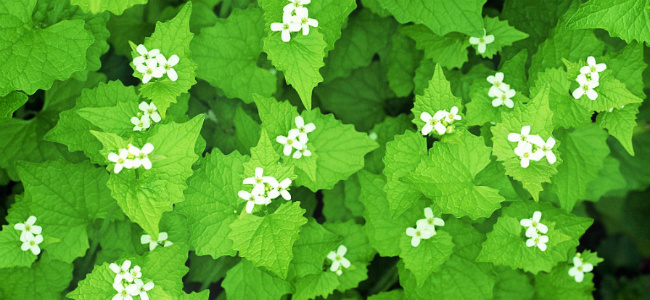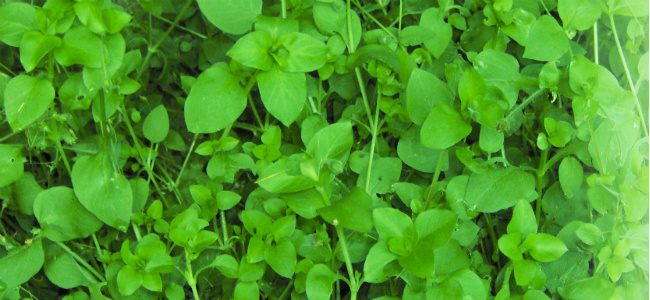15 Surprisingly Delicious Garden Weeds

Oh the poor weeds. Resilient and adaptable…yet disliked by all. They spoil the aesthetics of your carefully tended lawns, and seem to only exist to make your life difficult. But did you know weeds can be a great addition to your culinary adventures?
Believe it or not, the vast majority of your garden’s unsolicited pesky little green visitors can actually be eaten! Rich in vitamins, proteins and minerals, weeds are dinner opportunities just waiting to be seized – the best part is, they’re also free!
You have been fighting with the weeds in your garden for long enough. It’s time to turn them into friends – yummy and nutritious friends. Let’s take a look at the top 15 edible weeds in your garden.
1. Garlic Mustard

Also known as Jack-in-the-Bush and Poor Man’s Mustard, garlic mustard has a light garlic taste that is welcomed in any salad. A good reason you should consume this weed liberally is because garlic mustard is one of the most invasive plants you will ever see in your garden. It retains water and nutrients from the soil, thus harming the other plants. Our favorite garlic mustard recipe is to use it in pasta sauce: slice it up, add walnuts and garlic, blend it with olive oil, and add some parmesan cheese on top. This receipt will make garlic mustard your favorite unwanted plant in no time.
2. Dandelion

Did you know that dandelions are richer in beta-carotene than carrots? Beta-carotene is an organic compound beneficial to your immune system and eyesight. Dandelion is also an antioxidant and a source of Vitamin A. Both the dandelion leaves and flowers can be eaten, though the flowers can have a slightly bitter taste. The leaves are sweet when they are young, so early spring or late fall are the best times to include them in your salads. This does not mean that they should be discarded once they grow older. On the contrary, older dandelion leaves are great additions in your quiche or soup.
3. Nettle

Nettle is one of the key ingredients of a perfect cream soup. It can also be used to replace spinach, and tastes great when served with mashed potatoes. The benefits of nettle have been recognized in European medicine for centuries; it’s widely used as a tea to treat kidney and urinary disorders. Nettle is also fantastic for treating allergies and hay fever. So next spring or fall when you’re cursing at the ragweed for making you sneeze, make sure to pick up a few nettle leaves to brew as tea.
4. Purslane

Purslane is one of those plants you never really expected could be useful (or even heard of). Well, it turns out that this plant is succulent like aloe and jade, which means it is rich in Omega-3 fatty acids and Vitamin C! It also contains glutathione (an antioxidant), just like cabbage, cauliflower and asparagus. Purslane adds a crunchy and peppery note to your cucumber salad, and pairs wonderfully with pilaf or stew.
5. Clover

The only time you probably actually pay any attention to the clover is when your kids go hunting for the lucky four-leaf. However, it can be eaten too. Interesting fact: clover actually belongs to the pea family of plants. There is a reason why it is called the survival plant – both its flowers and leaves can be eaten, raw or cooked. The flowers tend to have a more pleasant taste, especially the white ones. Clover contains proteins, Vitamin B and Vitamin C. Try adding this lucky weed in your potato pancake mix, together with coriander and spring onions.
6. Japanese Knotweed

While this plant is native to Japan, China and Korea, the species is classified as one of the most invasive weeds in Europe and North America. It doesn’t matter how hard you try to get rid of the knotweed, it will likely come back – all the more reason to enjoy it in your food. Any recipe that works with rhubarb will do well with this plant. The taste of knotweed is difficult to describe…it’s crunchy and mild at the same time, a bit like kale but slightly more bitter. It is rich in resveratrol, which has anti-cancer and anti-aging properties.
7. Plantain

Plantain (the weed, not the banana-like fruit) has wide medicinal applications. It is rich in iron, calcium and Vitamins A, C, and K. Due to its antibacterial and anti-inflammatory properties, plantain is used externally to treat insect and snake bites, rashes and cuts, sunburn, eczema, psoriasis and other skin problems. A plantain-based balm should definitely be in your first aid kit: simply grind a cup of fresh plantain leaves, add a cup of olive oil, and pour in a tablespoon of melted beeswax. Once the concoction cools down, stir in a teaspoon of rosemary oil or Vitamin E oil. Plantain can also be consumed as a tea to help with indigestion, heartburn and diarrhea.
8. Sorrel

Sorrel is great for the eyesight, immune system, digestion, and circulation. It is an antioxidant rich in fiber and contains very few calories. Its lemony flavor gives a nice tartness to salads. When cooked, sorrel will lose some of its tartness, which makes it a nice addition to cream sauces, omelets, and soups. Due to the oxalic acid in the plant, sorrel should only be eaten in small amounts. Avoid cooking it in cast iron or aluminum pans, as it will take on an unpleasant metallic taste.
9. Wild Amaranth

A single wild amaranth plant produces approximately 50,000 seeds, which are a valuable source of proteins and amino acids that are not commonly found in grains. The seeds also contain calcium, iron, potassium, and three times more fiber than wheat.
10. Wild Grape Vines

Strange as it might sound, those grape vines growing all over old derelict houses are actually good for something else apart from invading your backyard. The grapes taste best after the first frost, and the young tender leaves can be a real culinary treat. You can blanch the leaves and use them to wrap minced meat, vegetables, or rice. This tasty dish is known as dolma and is popular in the Middle East and the Mediterranean.
11. Watercress

Watercress is an antioxidant bomb and can be often found in your local grocery store. Luckily, there is no need to buy something that is out there just waiting to be picked. Most of the time, you can find them growing by streams. It is full of iron, calcium, Vitamins A and C and Omega-3 fatty acids. Watercress helps digestion and protects against lung cancer. The perfect immunity booster for the upcoming winter can be made by blending watercress, mint leaves, 2 peeled kiwis, an orange and a lime.
12. Lamb’s Quarter

Lamb’s quarter is also known as “wild spinach.” It can be recognized by its triangular or diamond-shaped leaves, which have a white powder coating on them. All parts of the plant are edible except for the roots, which can be used as medicine instead. This weed is loaded with protein, calcium, iron, magnesium and Vitamins A and C. Similar to the sorrel, lamb’s quarter contains oxalic acid, which is why it should be eaten in moderation when raw. Cooking, however, will completely eliminate the acid. To prepare, you can simply sauté it in olive oil and then add spices of your choice.
13. Chickweed

Chickweed can be recognized by its hairy stem and pointed oval leaves. In folk medicine it is popularly used as a poultice for burns and rashes. As tea, it has characteristics of a mild diuretic. However, chickweed can cause diarrhea if taken in large quantities, so please consume in moderation. Keep in mind only the roots of this plant are inedible. Eaten raw, chickweed tastes like corn-on-the-cob. When cooked, it is similar to spinach.
14. Burdock

Burdock is cultivated for its sweet and crispy root, which can grow up to a meter. It is commonly used in macrobiotic diets and is also appreciated for its diuretic and a blood purifying properties. This weed can even stimulate the sex drive. Burdock root is a delicacy in Japanese cuisine, while in the UK, soft drinks made of dandelions and burdocks are quite popular. Try it out for yourself: put dandelion, burdock roots, ginger, and citric acid in a pot and boil for 20 minutes. Sieve the mixture and add honey. Finally, let it cool and mix in some soda water and ice for a tasty drink.
15. Curly Dock

Curly dock’s leaves are full of Vitamin A, protein and iron, which is why it is used to cure anemia. It’s best to eat the leaves when they’re still young and rolled up, because later on they become too bitter to be palatable. This weed should be eaten in moderation due to high levels of oxalic acid. Avoid it if you have a family history with kidney stones. A popular recipe is curly dock crackers: mix a cup of seed flour (one plant produces around 40,000 seeds, which you can use to make the flour) with a cup of whole wheat pastry flour (or any other you prefer) and a teaspoon of salt. Work the dough, roll it thin, cut into preferred shapes, and bake at 350 degrees (celcius) for 15 minutes. For the ultimate pleasure, top off your curly dock crackers with a bit of goat cheese.
What’s Next?
We know you’re super excited to get started, but before you do, please keep in mind:
- The soil you’re collecting the weeds from is not treated with pesticides
- Wash everything thoroughly before consumption
- Be cautious of any allergies you my have
Sources:
http://www.afha.us/garlic_mustard/gm_recipes.pdf
http://www.organicgardening.com/learn-and-grow/8-weeds-you-can-eat?page=0,1
http://www.treehugger.com/lawn-garden/eat-dandelions-9-edible-garden-weeds.html
http://www.goodhousekeeping.com/home/gardening/weeds-edible-plants-0409#slide-1
http://www.livescience.com/21496-5-edible-garden-weeds.html
http://www.wisebread.com/free-food-in-your-yard-edible-weeds
http://www.canadiangardening.com/food-and-entertaining/in-season/10-edible-weeds-to-enjoy-from-the-garden/a/35892
http://www.canadiangardening.com/how-to/pests-and-diseases/garlic-mustard-a-woodland-invader/a/22748
http://www.medicalnewstoday.com/articles/252758.php
http://www.motherearthnews.com/real-food/edible-weeds-zmaz76jaztak.aspx#axzz3MGEEPV7Z
http://www.eattheweeds.com/clover-available-around-the-world-2/






